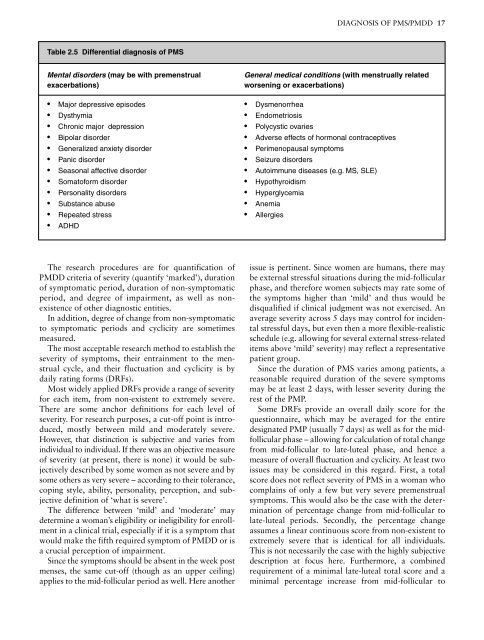Premenstrual Syndromes : PMS and PMDD - Rutuja :: The site ...
Premenstrual Syndromes : PMS and PMDD - Rutuja :: The site ...
Premenstrual Syndromes : PMS and PMDD - Rutuja :: The site ...
You also want an ePaper? Increase the reach of your titles
YUMPU automatically turns print PDFs into web optimized ePapers that Google loves.
Table 2.5 Differential diagnosis of <strong>PMS</strong><br />
<strong>The</strong> research procedures are for quantification of<br />
<strong>PMDD</strong> criteria of severity (quantify ‘marked’), duration<br />
of symptomatic period, duration of non-symptomatic<br />
period, <strong>and</strong> degree of impairment, as well as nonexistence<br />
of other diagnostic entities.<br />
In addition, degree of change from non-symptomatic<br />
to symptomatic periods <strong>and</strong> cyclicity are sometimes<br />
measured.<br />
<strong>The</strong> most acceptable research method to establish the<br />
severity of symptoms, their entrainment to the menstrual<br />
cycle, <strong>and</strong> their fluctuation <strong>and</strong> cyclicity is by<br />
daily rating forms (DRFs).<br />
Most widely applied DRFs provide a range of severity<br />
for each item, from non-existent to extremely severe.<br />
<strong>The</strong>re are some anchor definitions for each level of<br />
severity. For research purposes, a cut-off point is introduced,<br />
mostly between mild <strong>and</strong> moderately severe.<br />
However, that distinction is subjective <strong>and</strong> varies from<br />
individual to individual. If there was an objective measure<br />
of severity (at present, there is none) it would be subjectively<br />
described by some women as not severe <strong>and</strong> by<br />
some others as very severe – according to their tolerance,<br />
coping style, ability, personality, perception, <strong>and</strong> subjective<br />
definition of ‘what is severe’.<br />
<strong>The</strong> difference between ‘mild’ <strong>and</strong> ‘moderate’ may<br />
determine a woman’s eligibility or ineligibility for enrollment<br />
in a clinical trial, especially if it is a symptom that<br />
would make the fifth required symptom of <strong>PMDD</strong> or is<br />
a crucial perception of impairment.<br />
Since the symptoms should be absent in the week post<br />
menses, the same cut-off (though as an upper ceiling)<br />
applies to the mid-follicular period as well. Here another<br />
DIAGNOSIS OF <strong>PMS</strong>/<strong>PMDD</strong> 17<br />
Mental disorders (may be with premenstrual General medical conditions (with menstrually related<br />
exacerbations) worsening or exacerbations)<br />
● Major depressive episodes ● Dysmenorrhea<br />
● Dysthymia ● Endometriosis<br />
● Chronic major depression ● Polycystic ovaries<br />
● Bipolar disorder ● Adverse effects of hormonal contraceptives<br />
● Generalized anxiety disorder ● Perimenopausal symptoms<br />
● Panic disorder ● Seizure disorders<br />
● Seasonal affective disorder ● Autoimmune diseases (e.g. MS, SLE)<br />
● Somatoform disorder ● Hypothyroidism<br />
● Personality disorders ● Hyperglycemia<br />
● Substance abuse ● Anemia<br />
● Repeated stress ● Allergies<br />
● ADHD<br />
issue is pertinent. Since women are humans, there may<br />
be external stressful situations during the mid-follicular<br />
phase, <strong>and</strong> therefore women subjects may rate some of<br />
the symptoms higher than ‘mild’ <strong>and</strong> thus would be<br />
disqualified if clinical judgment was not exercised. An<br />
average severity across 5 days may control for incidental<br />
stressful days, but even then a more flexible-realistic<br />
schedule (e.g. allowing for several external stress-related<br />
items above ‘mild’ severity) may reflect a representative<br />
patient group.<br />
Since the duration of <strong>PMS</strong> varies among patients, a<br />
reasonable required duration of the severe symptoms<br />
may be at least 2 days, with lesser severity during the<br />
rest of the PMP.<br />
Some DRFs provide an overall daily score for the<br />
questionnaire, which may be averaged for the entire<br />
designated PMP (usually 7 days) as well as for the midfollicular<br />
phase – allowing for calculation of total change<br />
from mid-follicular to late-luteal phase, <strong>and</strong> hence a<br />
measure of overall fluctuation <strong>and</strong> cyclicity. At least two<br />
issues may be considered in this regard. First, a total<br />
score does not reflect severity of <strong>PMS</strong> in a woman who<br />
complains of only a few but very severe premenstrual<br />
symptoms. This would also be the case with the determination<br />
of percentage change from mid-follicular to<br />
late-luteal periods. Secondly, the percentage change<br />
assumes a linear continuous score from non-existent to<br />
extremely severe that is identical for all individuals.<br />
This is not necessarily the case with the highly subjective<br />
description at focus here. Furthermore, a combined<br />
requirement of a minimal late-luteal total score <strong>and</strong> a<br />
minimal percentage increase from mid-follicular to


